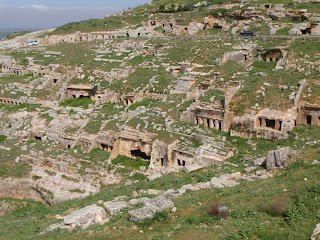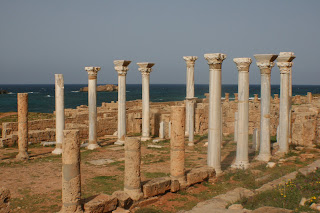
Sunday, April 13, 2008
Some Camels for You

The Greeks in Libya




Roman Mosaics
Nice toosh! 
Cyrene
Entrance to the Gymnasium

A Small Theatre 
Latin and Greek Writing in the Forum
Greek Baths built into a cliff face
Large Theatre
Temple of Apollo
Lion Statue in the Temple of Apollo 
The Necropolis - City of the Dead
Temple of Zeus
Cattle running across Roman Mosaic (there are no fences protecting the sites)
Appollonia - the port city that serviced Cyrene
Detail on Column





Saturday, April 12, 2008
Honouring the Rats of Tobruk
The area around Tobruk is harsh and unforgiving – it is desert, rocky and flat with practically no vegetation. The day we visited we experienced the heat, wind and sand, giving us a little insight into what it must have been like for the soldiers. I can only imagine what a hell it must have been for both sides fighting there. The town of Tobruk itself is pretty run down and dirty these days, but we have heard stories about how beautiful it once was. Outside the town lies four war cemeteries (French, German and two for Commonwealth countries), all of which we visited. We also saw the site of the Fig Tree Hospital – an underground cavern in which soldiers were treated. Overall, it was an incredibly moving experience, something I will not forget in a hurry.

The Desert Landscape - harsh and unforgiving


Trenches - the more permanent ones were originally built by Italian Forces as can be seen by the inscriptions. Bunkers were built off the side of them for the soldiers to stay in.
 Bunker
Bunker
The Fig Tree Hospital
The German War Memorial...Exterior
Interior...
An unknown soldiers grave - French Cemetry
So many dead - Knightsbridge Commonwealth Cemetry
Jack Edmondson VC - An Australian War Hero
Lost in Time...

Inside...

Nalut which is located on the western end of the Jebel Nafusa (Nafusa Mountains) and also has a Berber granary.
Looking up to the Berber Granary at Nalut - it is positioned on top of steep hill (good for defence!!)

Ruins of the old town



We arrived in Ghadames in the evening. The next morning we had a guided tour through the old town of Ghadames – a UNESCO world heritage site and a must for any visitor to Libya. The town has a long history – it is believed that there have been people living in the area since at least 3000BC. The old city that can be seen today was probably founded around 800 years ago and people only stopped living there in the late 1980’s – the government built a new town alongside with more modern facilities. However, families still own their houses in the old city and go back regularly, especially in summer as it is much cooler. This is because the mud brick city has been built with covered walkways and public meeting spaces so that people can get around without having to expose themselves tot he harsh sun too much. It was quite warm the day we were there and you could really fwel how cool the city was compare to outside. The city also incorporates small gardens, fields and orchards to supply the citizens with fresh food. There is also a natural spring from which fresh water flows. Words can not really describe how beautiful the old city is and the photos only give a small view of what it is like.









A hand imprint in the wall to ward off evil

A man selling his wares
Just beautiful...


A shady courtyard
The next day we headed back to Tripoli, via Kabaw which also has a sensational Berber granary.


Sahara Gal

















